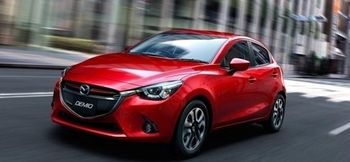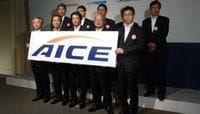
Mazda is doing its first full model change for the Mazda2 in seven years, and will begin sales worldwide starting with Japan in the fall of 2014. The price in Japan is expected to be approximately ¥1.4–¥1.9 million. Amid a new model offensive by competitors with hybrid compact cars and minicars in the domestic market, hopes for a rally by Mazda rest with the new models.
The advance reviews are superb. It uses the new standardized design adopted in 2012, so it has dynamic looks similar to luxury models like the Mazda6 and Mazda3 despite being a compact car. The interior also gives a sense of high quality for a compact car. The body, engine, and transmission have been completely redone, improving driving performance and fuel efficiency.
Fuel Efficiency of 30km/L
A particular focus for attention is the inclusion in the lineup of a variant equipped with a 1.5 liter compact diesel engine. Its fuel efficiency is 30km per liter of diesel, putting it in the highest class for engine-powered vehicles, excluding hybrids and minicars. It runs on diesel, which is taxed at a lower rate, so when comparing fuel costs, it works out roughly equivalent to a gasoline-driven hybrid. The price of the vehicle itself is also expected to be comparable to hybrids in the same class, making it competitive on price as well.
Without hybrid vehicles—which have earned strong support in the domestic market, diesels are a distinguishing point for Mazda which competitors lack. With the Mazda2, while it may not sell as well as the more exciting high-end models, it is likely to have a significant effect in showcasing the brand’s uniqueness and competitiveness in fuel efficiency.
The new Demio is a powerful weapon in the effort to reclaim domestic market share, but there is one cause for concern: the trouble with the “Mazda Connect” standard equipment navigation system. Mazda Connect is the new standard equipment navigation system introduced with the new Mazda3 released in 2013. It debuted with great fanfare as a next generation system featuring network connectivity with social media etc., but the performance of the main navigation function was poor, with problems such as errors in the map data, resulting in less than favorable reviews. Diatribes on Internet message boards aside, even on the official website—where criticism is normally uncommon, there were more than a few critical comments from users.
Of course, Mazda has made efforts to deal with the issues, such as conducting two service campaigns offering free servicing. However, it has still not reached the level that typical users in Japan expect from a navigation system.
High Standards for Navigation Systems
For the Demio, the navigation system’s performance is particularly important, since it is a compact car for everyday use. It is different from luxury cars where users might be attracted to the car’s driving performance or design even if they are dissatisfied with the navigation system. It is a category in which comparatively greater emphasis is placed on economy and usability over driving performance and design. Japanese users in particular are the most demanding in the world when it comes to navigation systems.
According to Mazda, not only will the version of Mazda Connect installed in the new Demio be equipped with software that fixes the bugs, they are also planning to offer navigation systems other than Mazda Connect. The Demio uses new reduced-cost platforms throughout, so its sales will have a significant impact on Mazda’s bottom line. They need to make sure everything is in order prior to the release.




